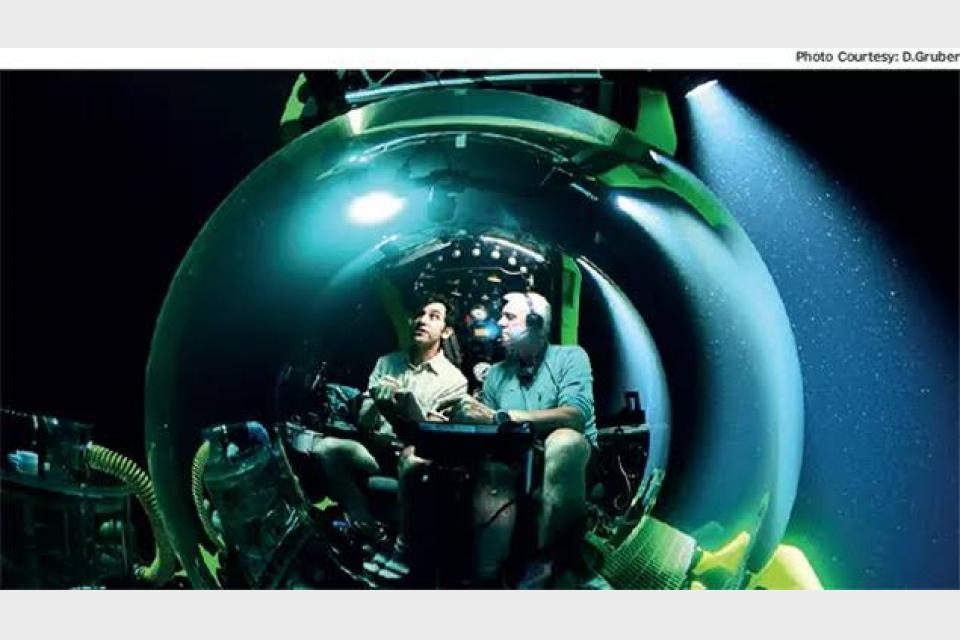David Gruberis a marine biologist and professor of environmental science at the City University of New York. Speaking to Srijana Mitra Das at Times Evoke, he discusses amazing oceanic species:
As a marine biologist, there are two main aspects to my work. The first is to try and look beyond our human perspective and see the world from the eyes of marine creatures. The second is to develop ‘gentle robotics’ or technology for marine biology that isn’t intrusive but which can bring us closer to unique marine animals.
I began by working with corals. A team of neuroscientists were interested in studying the phenomenon of fluorescence in species to understand the brain better. They approached me in the quest to find new biofluorescent markers — I began researching why corals make so much of one particular protein which causes them to be fluorescent. This composes fifteen percent of the protein in corals — if they produce so much of this, it must be for a very important reason. I found corals could use biofluorescence as an attractant for microbes with whom they have a symbiotic relationship — microbes have very good photo receptors and c an see different colours. So, this could be a great way to signal microbes to inhabit corals.
GLOWING IN THE DARK: Marine scientists have discovered the fluorescent Hippocampus erectus seahorse, a shy little creature which lights up the sea.
We then found fluorescence in fishes — we published a paper about 180 species that had biofluorescence, in cluding Arctic snailfish, gobies and breams. They use biofluorescence as camouflage or to call to other fish with the same phenomena. Then, we found biofluorescence in sharks — building a ‘shark-eye vision’ camera, we began swimming with sharks to understand what fluorescence means to them. We found the molecule causing fluorescence in sharks is an anti-microbial. So, nothing will ever grow on these sharks, even if they just sit at the bottom of the sea. We’ve even found biofluorescence in a sea turtle — to understand this better, we’ve been using hyper-spectral imaging to design a ‘turtle-eye camera’.
LIVING IN A YELLOW SUBMARINE: David Gruber and other marine scientists explored the ocean’s mysteries in the RV Alucia submarine off Brazil’s coast.
Marine biofluorescence is stimulated by blue light. These species can absorb blue light and transform it into greens, oranges and reds — this is very interesting given that the ocean is one big blue filter. If you are scuba diving about thirty feet down, the red light from the sun is absorbed by the water, so there is no red there. But if you see a red coral at fifty feet, that’s not coming from the sun — it’s blue light hitting the coral, which then makes its own red light out of it.

GLEAMING GREEN: An acanthurid shines with biofluorescence which turns blue light into vivid colours. Photo courtesy: David Gruber and John Sparks
This creates extraordinary beauty. I found bioluminescence in flashlight fish in the South Pacific — they can make their own light, like a firefly. I was underwater in a remote reef with tens of thousands of these fish, all blinking in the night sea, making shapes and patterns, coming together in a ball and dispersing — it was one of the most beautiful sights in my life. It is certainly possible that the deep sea is actually filled with billions of such bioluminescent fish which humans have never even seen.
In 2014, I met Professor Robert Wood of Harvard. We were both becoming National Geographic Explorers and started a project called ‘Squishy Robotic Fingers’, very soft technology which can work delicately with corals. We then developed ultra-gentle robotic ‘linguine fingers’ — this was tested on a jellyfish, a very fragile animal, and it was found the jellyfish experienced no stress. These scientific tools interact carefully with marine animals, studying them and letting them go with utmost gentleness.

HOW TO MAKE A MAGIC GARDEN: Coral reefs exhibit biofluorescence which attracts marine microbes and fish to live in them, thus creating biodiverse communities over many years.
Marine animals are extraordinary — there is a sea sponge that can live for 18,000 years. Humans need to be very careful about how we interact with these beings. As scientists, our approach to the sea contrasts with activities like deep-sea mining which just vacuums up minerals from the ocean floor, razing through the habitat of these unique animals. Climate change is also impacting marine life.
I started diving in the Caribbean twenty years ago — today, many of the reefs I’ve seen have vanished or have very few species left in them. It can take thousands of years to build a healthy coral reef with a thriving ecosystem. Yet, human actions are wrecking these rapidly. For me, it’s very difficult to see the decline of corals but it is also very important to witness and communicate this. We can all help marine conservation by getting involved in citizen science projects, joining beach cleanups and researching the sustainability of commodities.
Some products have harmful impacts on fish and people need information about this. I’m now studying whales, using advanced machine learning and gentle robotics to try to decipher their language — we’ve established a non-profit organisation called Project CETI (Cetacean Translation Initiative). I believe we humans need to listen to animals, understand them and protect them. A lot of technology has taken us far away from the world of nature. As a marine scientist, I want to see the development of technology that brings us closer now to these amazing beings we share our world with.









